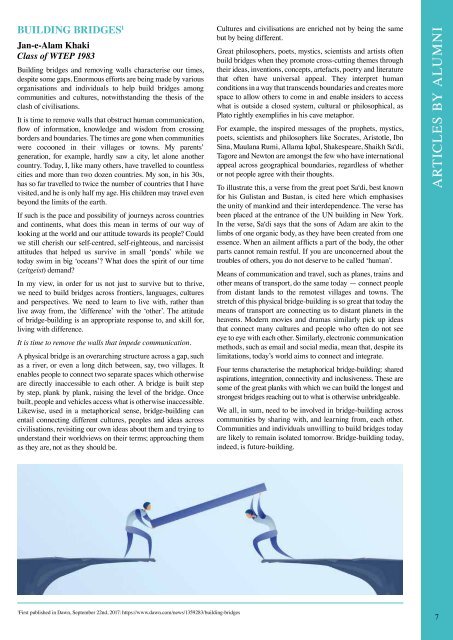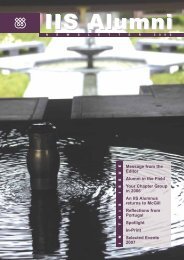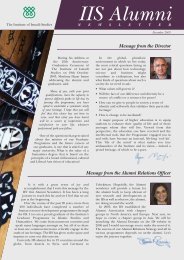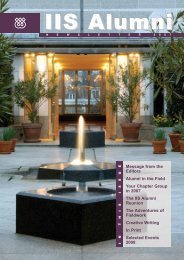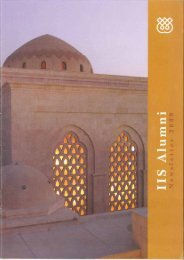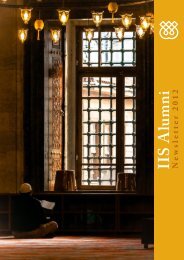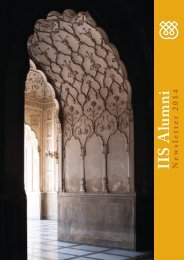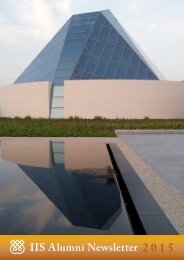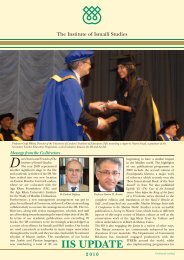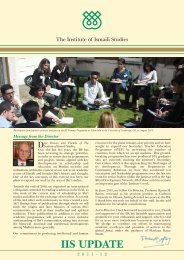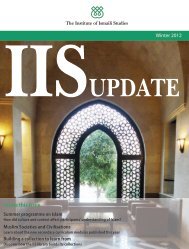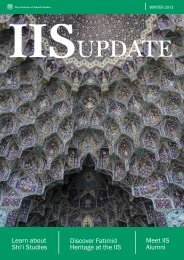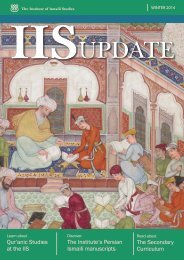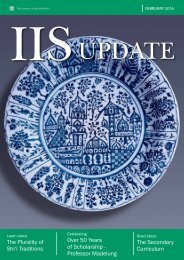IIS Alumni Newsletter 2017
Create successful ePaper yourself
Turn your PDF publications into a flip-book with our unique Google optimized e-Paper software.
BUILDING BRIDGES 1<br />
Jan-e-Alam Khaki<br />
Class of WTEP 1983<br />
Building bridges and removing walls characterise our times,<br />
despite some gaps. Enormous efforts are being made by various<br />
organisations and individuals to help build bridges among<br />
communities and cultures, notwithstanding the thesis of the<br />
clash of civilisations.<br />
It is time to remove walls that obstruct human communication,<br />
flow of information, knowledge and wisdom from crossing<br />
borders and boundaries. The times are gone when communities<br />
were cocooned in their villages or towns. My parents’<br />
generation, for example, hardly saw a city, let alone another<br />
country. Today, I, like many others, have travelled to countless<br />
cities and more than two dozen countries. My son, in his 30s,<br />
has so far travelled to twice the number of countries that I have<br />
visited, and he is only half my age. His children may travel even<br />
beyond the limits of the earth.<br />
If such is the pace and possibility of journeys across countries<br />
and continents, what does this mean in terms of our way of<br />
looking at the world and our attitude towards its people? Could<br />
we still cherish our self-centred, self-righteous, and narcissist<br />
attitudes that helped us survive in small ‘ponds’ while we<br />
today swim in big ‘oceans’? What does the spirit of our time<br />
(zeitgeist) demand?<br />
In my view, in order for us not just to survive but to thrive,<br />
we need to build bridges across frontiers, languages, cultures<br />
and perspectives. We need to learn to live with, rather than<br />
live away from, the ‘difference’ with the ‘other’. The attitude<br />
of bridge-building is an appropriate response to, and skill for,<br />
living with difference.<br />
It is time to remove the walls that impede communication.<br />
A physical bridge is an overarching structure across a gap, such<br />
as a river, or even a long ditch between, say, two villages. It<br />
enables people to connect two separate spaces which otherwise<br />
are directly inaccessible to each other. A bridge is built step<br />
by step, plank by plank, raising the level of the bridge. Once<br />
built, people and vehicles access what is otherwise inaccessible.<br />
Likewise, used in a metaphorical sense, bridge-building can<br />
entail connecting different cultures, peoples and ideas across<br />
civilisations, revisiting our own ideas about them and trying to<br />
understand their worldviews on their terms; approaching them<br />
as they are, not as they should be.<br />
Cultures and civilisations are enriched not by being the same<br />
but by being different.<br />
Great philosophers, poets, mystics, scientists and artists often<br />
build bridges when they promote cross-cutting themes through<br />
their ideas, inventions, concepts, artefacts, poetry and literature<br />
that often have universal appeal. They interpret human<br />
conditions in a way that transcends boundaries and creates more<br />
space to allow others to come in and enable insiders to access<br />
what is outside a closed system, cultural or philosophical, as<br />
Plato rightly exemplifies in his cave metaphor.<br />
For example, the inspired messages of the prophets, mystics,<br />
poets, scientists and philosophers like Socrates, Aristotle, Ibn<br />
Sina, Maulana Rumi, Allama Iqbal, Shakespeare, Shaikh Sa‘di,<br />
Tagore and Newton are amongst the few who have international<br />
appeal across geographical boundaries, regardless of whether<br />
or not people agree with their thoughts.<br />
To illustrate this, a verse from the great poet Sa‘di, best known<br />
for his Gulistan and Bustan, is cited here which emphasises<br />
the unity of mankind and their interdependence. The verse has<br />
been placed at the entrance of the UN building in New York.<br />
In the verse, Sa‘di says that the sons of Adam are akin to the<br />
limbs of one organic body, as they have been created from one<br />
essence. When an ailment afflicts a part of the body, the other<br />
parts cannot remain restful. If you are unconcerned about the<br />
troubles of others, you do not deserve to be called ‘human’.<br />
Means of communication and travel, such as planes, trains and<br />
other means of transport, do the same today — connect people<br />
from distant lands to the remotest villages and towns. The<br />
stretch of this physical bridge-building is so great that today the<br />
means of transport are connecting us to distant planets in the<br />
heavens. Modern movies and dramas similarly pick up ideas<br />
that connect many cultures and people who often do not see<br />
eye to eye with each other. Similarly, electronic communication<br />
methods, such as email and social media, mean that, despite its<br />
limitations, today’s world aims to connect and integrate.<br />
Four terms characterise the metaphorical bridge-building: shared<br />
aspirations, integration, connectivity and inclusiveness. These are<br />
some of the great planks with which we can build the longest and<br />
strongest bridges reaching out to what is otherwise unbridgeable.<br />
We all, in sum, need to be involved in bridge-building across<br />
communities by sharing with, and learning from, each other.<br />
Communities and individuals unwilling to build bridges today<br />
are likely to remain isolated tomorrow. Bridge-building today,<br />
indeed, is future-building.<br />
ARTICLES BY ALUMNI<br />
1<br />
First published in Dawn, September 22nd, <strong>2017</strong>: https://www.dawn.com/news/1359283/building-bridges<br />
7


